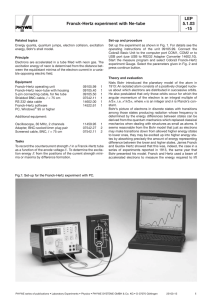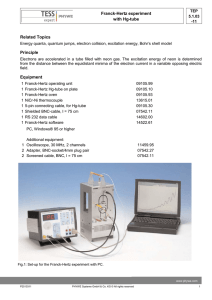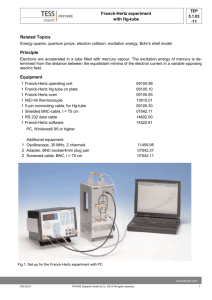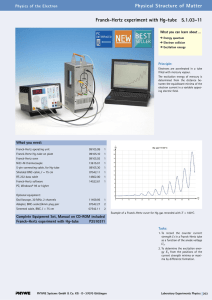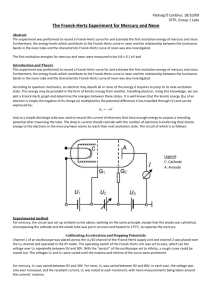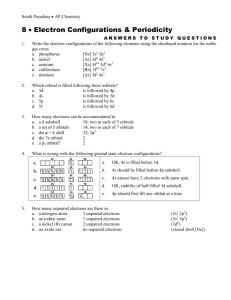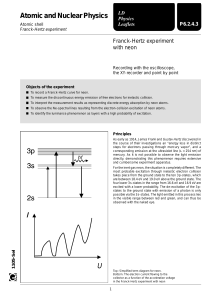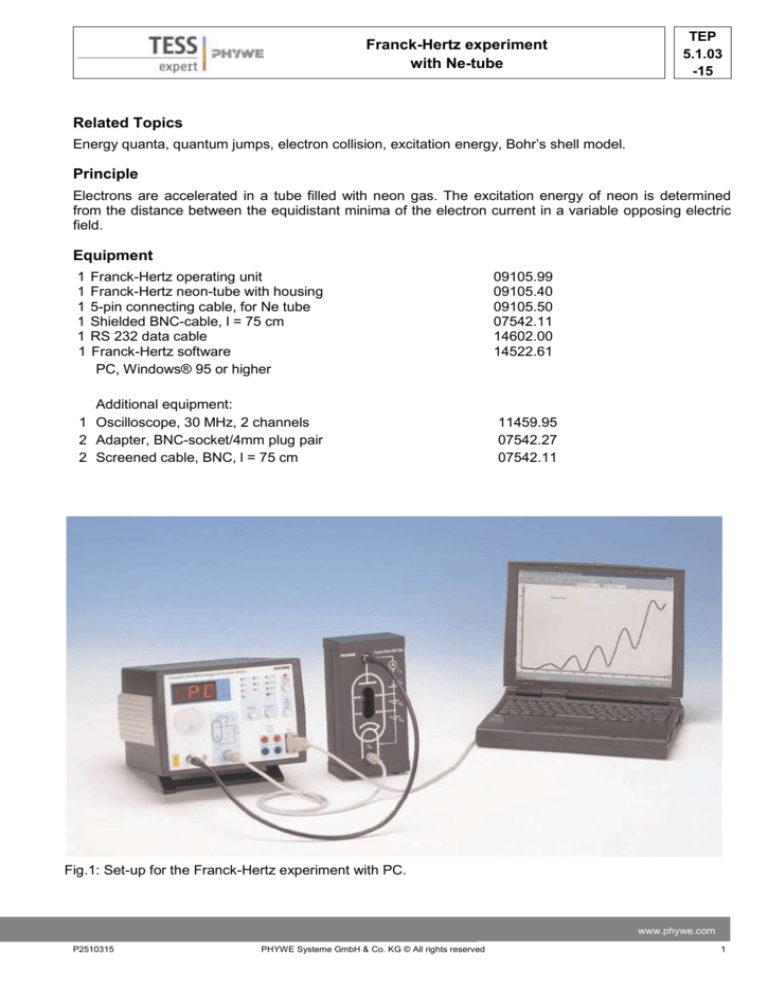
Franck-Hertz experiment
with Ne-tube
TEP
5.1.03
-15
Related Topics
Energy quanta, quantum jumps, electron collision, excitation energy, Bohr’s shell model.
Principle
Electrons are accelerated in a tube filled with neon gas. The excitation energy of neon is determined
from the distance between the equidistant minima of the electron current in a variable opposing electric
field.
Equipment
1
1
1
1
1
1
Franck-Hertz operating unit
Franck-Hertz neon-tube with housing
5-pin connecting cable, for Ne tube
Shielded BNC-cable, l = 75 cm
RS 232 data cable
Franck-Hertz software
PC, Windows® 95 or higher
Additional equipment:
1 Oscilloscope, 30 MHz, 2 channels
2 Adapter, BNC-socket/4mm plug pair
2 Screened cable, BNC, l = 75 cm
09105.99
09105.40
09105.50
07542.11
14602.00
14522.61
11459.95
07542.27
07542.11
Fig.1: Set-up for the Franck-Hertz experiment with PC.
www.phywe.com
P2510315
PHYWE Systeme GmbH & Co. KG © All rights reserved
1
TEP
5.1.0315
Franck-Hertz experiment
with Ne-tube
Tasks
-
Record the countercurrent strength I in a Franck-Hertz tube as a function of the anode voltage U.
Determine the excitation energy E from the positions of the current strength minima or maxima by difference formation.
Set-up and Procedure
Set up the experiment as shown in Fig. 1. For details see the operating instructions of the unit
09105.99. Connect the Cobra3 Basic Unit to the
computer port COM1, COM2 or to USB port (use
USB to RS232 Adapter Converter 14602.10). Start
the measure program and select Cobra3 FranckHertz experiment Gauge. The window “FrankHertz-experiment – measuring” (see Fig. 2) appears. The optimum parameters are different for
each Ne-tube. You find the specific parameters for
your device on a sheet which is enclosed in the
package of the Ne-tube. Choose the parameters
for U1, U2, U3 and UH as given on that sheet and
make sure that the rest is set as shown in Fig. 2.
Press the continue button.
Fig. 2: Measuring parameters.
Theory and evaluation
Niels Bohr introduced the planetary model of the
atom in 1913: An isolated atom consists of a positively charged nucleus about which electrons are
distributed in successive orbits. He also postulated
that only those orbits occur for which the angular
momentum of the electron is an integral multiple of
h/2π, i.e. n*h/2π, where n is an integer and h is
Planck’s constant. Bohr’s picture of electrons in
discrete states with transitions among those states
producing radiation whose frequency is determined
by the energy differences between states can be
derived from the quantum mechanics which replaced classical mechanics when dealing with Fig. 3: Principle of the measurement.
structures as small as atoms. It seems reasonable
from the Bohr model that just as electrons may
make transitions down from allowed higher energy states to lower ones, they may be excited up into
higher energy states by absorbing precisely the amount of energy representing difference between the
lower and higher states. James Franck and Gustav Hertz showed that this was, indeed, the case in a series of experiments reported in 1913, the same year that Bohr presented his model. Franck and Hertz
used a beam of accelerated electrons to measure the energy required to lift electrons in the ground state
of a gas of mercury atoms to the first excited state (see experiment 5.1.03-11). In present experiment a
tube filled with neon gas is used.
The electrons emitted by a thermionic cathode are accelerated between cathode C and anode A in the
tube filled with neon gas (Fig. 3) and are scattered by elastic collision with neon atoms. From an anode
2
PHYWE Systeme GmbH & Co. KG © All rights reserved
P2510315
Franck-Hertz experiment
with Ne-tube
TEP
5.1.03
-15
voltage U1 of 16,8 V, however, the kinetic energy of
the electrons is sufficient to bring the valence electron of the neon to the first excitation level by an inelastic collision. Because of the accompanying loss
of energy, the electron can now no longer traverse
the opposing field between anode A and counter
electrode S: the current I is at a minimum. If we
now increase the anode voltage further, the kinetic
energy of the electron is again sufficient to surmount the opposing field: the current strength I increases. When U1 = 2∙16.8 V the kinetic energy is
so high that two atoms in succession can be excited by the same electron: we obtain a second minimum (Fig. 4). The graph of I/U1 thus shows equiFig. 4: Example of a Franck-Hertz curve recorded with
distant maxima and minima.
Netube.
These minima are not, however, very well-defined
because of the initial thermal distribution of the electron velocities. The voltage U1 between anode and
cathode is represented by
𝑈1 = 𝑈 + (ΦA − ΦC )
where U is the applied voltage, and ΦA and ΦC the work function voltages of the anode and cathode respectively. As the excitation energy E is determined from the voltage differences at the minima, the work
function voltages are of no significance here. According to the classical theory the energy levels to which
the mercury atoms are excited could be random. According to the quantum theory, however, a definite
energy level must suddenly be assigned to the atom in an elementary process. The course of the I/UA
curve was first explained on the basis of this view and thus represents a confirmation of the quantum
theory. The excited neon atom again releases the energy it has absorbed, with the emission of a photon.
When the excitation energy E is 16.8 eV, the wavelength of this photon is
𝜆=
𝑐ℎ
= 73.8 𝑛𝑚
𝐸
where c = 2.9979 · 108
𝑚
𝑠
and h = 4.136 · 10-15 eV.
For our evaluation we determine the voltage values of the minima. From the differences between these
values we obtain the excitation energy E of the neon atom by taking an average. By evaluating the
measurements in Fig. 4 we obtained the value
E = (17.4 ± 0.7) eV.
www.phywe.com
P2510315
PHYWE Systeme GmbH & Co. KG © All rights reserved
3

